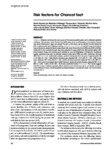Use este identificador para citar ou linkar para este item:
http://www.alice.cnptia.embrapa.br/alice/handle/doc/1041258Registro completo de metadados
| Campo DC | Valor | Idioma |
|---|---|---|
| dc.contributor.author | NÓBREGA, M. B. DE M. | pt_BR |
| dc.contributor.author | ARAS, R. | pt_BR |
| dc.contributor.author | MARTINS NETTO, E. | pt_BR |
| dc.contributor.author | COUTO, R. D. | pt_BR |
| dc.contributor.author | MARINHO, A. M. DA N. | pt_BR |
| dc.contributor.author | SILVA FILHO, J. L. da | pt_BR |
| dc.contributor.author | COLARES, V. N. Q. | pt_BR |
| dc.contributor.author | CAMPELO, P. L. | pt_BR |
| dc.contributor.author | NUNES, M. A. L. | pt_BR |
| dc.date.accessioned | 2016-03-17T11:11:11Z | pt_BR |
| dc.date.available | 2016-03-17T11:11:11Z | pt_BR |
| dc.date.created | 2016-03-17 | pt_BR |
| dc.date.issued | 2015 | pt_BR |
| dc.identifier.citation | Archives of Endocrinology and Metabolism, São Paulo, v. 59, n. 3, p. 226-230, June 2015. | pt_BR |
| dc.identifier.uri | http://www.alice.cnptia.embrapa.br/alice/handle/doc/1041258 | pt_BR |
| dc.description | Objective: Diabetes mellitus is the main cause of Charcot neuroarthropathy and is clinically classified as follows: Charcot foot, acute Charcot foot (ACF) when there is inflammation, and inactive Charcot foot when inflammatory signs are absent. The aim of this study was to identify the risk factors for ACF in patients with type 2 diabetes mellitus. Materials and methods: A matched case-control study was conducted to assess the factors associated with acute Charcot foot from February 2000 until September 2012. Four controls for each case were selected 47 cases of ACF and 188 controls without ACF were included. Cases and controls were matched by year of initialization of treatment. Conditional logistic regression was used to estimate matched odds ratios (ORs) and 95% confidence intervals (95% CIs). Results: In multivariate analysis, patients having less than 55 years of age (adjusted OR = 4.10, 95% CI = 1.69 ? 9.94), literate education age (adjusted OR = 3.73, 95% CI = 1.40 ? 9.92), living alone (adjusted OR = 5.84, 95% CI = 1.49 ? 22.86), previous ulceration (adjusted OR = 4.84, 95% CI = 1.62 ? 14.51) were at increased risk of ACF. However, peripheral arterial disease (adjusted OR = 0.16, 95% CI = 0.05 ? 0.52) of 6.25 (1.92 ? 20.0) was a protective factor. Discussion: The results suggest that PCA in type 2 diabetes primarily affects patients under 55 who live alone, are literate, and have a prior history of ulcers, and that peripheral arterial disease is a protective factor. Arch Endocrinol Metab. 2015;59(3):226-30. | pt_BR |
| dc.language.iso | eng | eng |
| dc.rights | openAccess | eng |
| dc.subject | Charcot foot | pt_BR |
| dc.subject | Charcot neuroarthropathy | pt_BR |
| dc.title | Risk factors for charcot foot. | pt_BR |
| dc.type | Artigo de periódico | pt_BR |
| dc.date.updated | 2016-03-24T11:11:11Z | pt_BR |
| dc.subject.thesagro | Diabete | pt_BR |
| dc.subject.nalthesaurus | diabetes mellitus | pt_BR |
| dc.subject.nalthesaurus | diabetic neuropathy | pt_BR |
| riaa.ainfo.id | 1041258 | pt_BR |
| riaa.ainfo.lastupdate | 2016-03-24 | pt_BR |
| dc.contributor.institution | MARTA BARRETO DE MEDEIROS NÓBREGA, UFBA; ROQUE ARAS, UFBA; EDUARDO MARTINS NETTO, UFBA; RICARDO DAVID COUTO, UFBA; ALEXANDRE MAGNO DA NÓBREGA MARINHO, UFCG; JOAO LUIS DA SILVA FILHO, CNPA; VÍCTOR NÓBREGA QUINTAS COLARES, FCM/CESED - PARAÍBA; PRISCILLA LEITE CAMPELO, UFCG; MARCOS ANDRÉ LIMA NUNES, UFCG. | pt_BR |
| Aparece nas coleções: | Artigo em periódico indexado (CNPA)  | |
Arquivos associados a este item:
| Arquivo | Descrição | Tamanho | Formato | |
|---|---|---|---|---|
| Riskfactorsforcharcotfoot.pdf | 102,15 kB | Adobe PDF |  Visualizar/Abrir |









